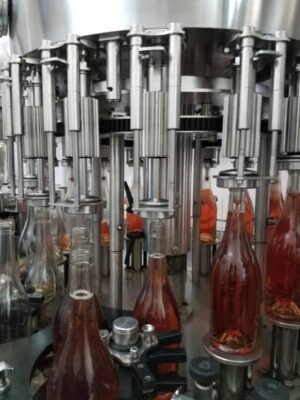Wine is one of the most heavily regulated products on both federal and state levels — and the regulatory environments change frequently, so vigilance is vital.
By Michael Kaiser
WineAmerica (WA), the National Association of American Wineries, exists to “encourage the growth and development of American wineries and winegrowing through the advancement and advocacy of sound public policy.” In other words, WA seeks to protect and enhance the business climate for wine.
![The 2023 Farm Bill is on WineAmerica's current agenda. [iStock]](https://wineindustryadvisor.com/wp-content/uploads/2022/07/istockphoto-1208801336-612x612-1.jpeg)
This primarily involves working with Congress. WA has achieved a lot in recent years, primarily passage of the Craft Beverage Modernization and Tax Reform Act (CBMTRA), which saves money for wineries of all sizes. This year, WA’s focus includes a bill to allow direct-to-consumer alcohol shipping by the U.S. Postal Service, transparency in music licensing and development of the 2023 Farm Bill.
Legislation is only part of what WineAmerica does on behalf of American wineries, however. It also interfaces with the Executive Branch of the Federal Government, primarily with the Alcohol and Tobacco Tax and Trade Bureau (TTB), which is part of the Department of Treasury.
The Regulatory Environment
From time to time, TTB will publish what are known as Notice of Proposed Rulemakings (NPRN). These are issued whenever there’s a petition for a new American Viticultural Area (AVA), as well as for any other potential changes to the rules and regulations TTB uses to operate. (There are certain regulatory items, such as tax rates, that cannot be changed through an NPRN, but must be amended through legislation.)
When the TTB issues an NPRN, it invites the public to submit comments in relation to the proposal. WineAmerica routinely submits comments on behalf of not only its dues-paying membership, but the wine industry as a whole.
Every calendar year, the TTB puts out myriad rulemaking proposals. It will ask for comments, which it will review and then make a decision on the proposal. This year, it is working with the Treasury Department to address disparities between large and small producers.
Executive Order on Competition
Last year, the Biden Administration issued an executive order to examine competition in domestic markets, including the alcohol marketplace. After these findings were released, the Treasury Department was tasked with issuing a report on what the federal government could do to help ease the burden on small alcohol producers, primarily from a regulatory standpoint. Part of the Treasury report focused on steps the TTB could take to “ease the [industry’s] regulatory burden.” To that end, the TTB has begun to issue NPRNs to address these concerns, much of which would have already been addressed with the competition order. Proposals include rulings on allowable bottle sizes and shapes, and labeling changes for fortified wine, among others.

Standards of Fill. A mere three years after the last NPRN on standards of fill for wine, the TTB has issued another notice (No. 210) to further amend the regulations by allowing 10 additional authorized standards of fill for wine, potentially raising the total to 22. The TTB is also considering, as an alternative, eliminating all but a minimum standard of fill for wine containers (50mL) and all but a minimum and a maximum for distilled spirits containers. The idea is to “eliminate regulatory requirements, reduce barriers to competition and provide consumers with broader purchasing options.”
WineAmerica is strongly opposed to eliminating all but the minimum standards of fill for wine. We do support limited additions to the existing standards of fill; however, any additions to the existing allowable standards of fill should stem from a request from a large segment of the wine industry, and not just one or two producers or importers, as in this case. We do not believe this is the proper way to add new standards of fill into the existing regulations.
In addition, the proposed total deregulation of this federal standard would cause unnecessary consumer confusion, significant disruption to business operations, difficulty with assuring compliance across state lines and unnecessary expenditure of state resources to create standards in lieu of the federal standards of fill. (See “Rethinking TTB’s Standards of Fill Regulations” for more information.)

Labels for Wines Containing Added Distilled Spirits. Last month, TTB proposed an amendment to labeling regulations for wines with added distilled spirits, aka fortified wines. Current regulations prohibit wineries from listing added spirits on wine labels or from noting that a wine has been fortified. TTB has prohibited the use of “fortified” or the inclusion of spirits on wine labels because, it claims, listing added spirits would imply “intoxicating qualities” to the consumer.
The word “fortified” has its own baggage. TTB has, in the past, viewed the idea of using “fortified” to describe certain grape wines as problematic, given that Food and Drug Administration (FDA) regulations use the word “fortified” to describe foods with added vitamins, minerals or protein. TTB took the position that authorizing the use of the term “fortified” in a way inconsistent with the FDA regulations could create consumer confusion.
WineAmerica and many other individuals and organizations in the wine industry view both of these points as antiquated and simply not consistent with where the wine industry is. Wineries want to be upfront with consumers about their products, and a full and truthful statement of fortified wine on the product’s label would do just that.
More Changes Coming
What’s next on the horizon? We have it on good authority that TTB will address nutritional information, serving facts and ingredient labeling next. Stay tuned for more information in the coming weeks and months.
___________________________________________________________________________

Michael Kaiser is executive vice president and director of government affairs at WineAmerica, which represents wineries and associations from more than 40 states. For more information about WineAmerica and how to get involved, visit www.wineamerica.org.

















